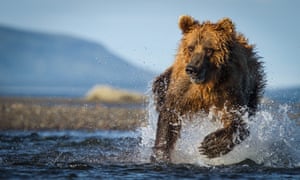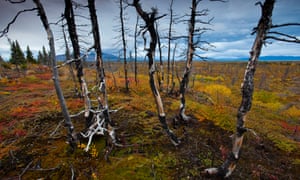Extract from The Guardian
Back
in my youth, while in Montana, I came across Berkeley Pit, called “the
richest hill on earth.” There, churches and historic neighborhoods were
bulldozed to expand the pit so greedy men could make their fortunes
mining copper, silver and gold. After the riches were extracted, and
problems arose, those men absolved themselves of any wrongdoing, and
left. Over time, the mine closed and the pit began to fill with an
acidic brew so toxic that when snow geese landed there, they died. As it
threatened Montana’s groundwater, the pit became an Environmental
Protection Agency (EPA) superfund site that would cost American
taxpayers billions of dollars for generations.
I fear the same awaits Alaska’s Pebble Mine, a nightmare proposed by the Canadian mining company, Northern Dynasty. Don’t be fooled by the name. For many Alaskans, Pebble is a boulder on their heart. If built, it would be a massive pit one mile in diameter and 600ft deep. It would obliterate 3,500 acres of wetlands and 80-plus miles of salmon streams, and produce an estimated 10 billion tons of waste. Earthen dams would hold back toxic mine tailings, all in earthquake country, in the headwaters of Bristol Bay, the richest sockeye salmon run in the world. What could go wrong?
In 2014, a 40-meter-high earthen dam that contained a massive copper and gold tailings pond at Mount Polley Mine, in British Columbia, failed. A toxic slurry emptied downstream into lakes and waterways, including Quesnel Lake, until then the cleanest deep water lake in the world. Knight Piésold, the geotechnical consulting firm that provided the design and supervised construction (and paid no post-disaster fines), is the same firm Northern Dynasty has hired to build the earthen dams at Pebble.
"An earthen dam would hold back toxic mine tailings, all in earthquake country"
And who will pay to remediate the Mount Polley mess, the biggest mine
disaster in Canada’s history? Taxpayers, to the tune of an estimated
$40m-100m.I fear the same awaits Alaska’s Pebble Mine, a nightmare proposed by the Canadian mining company, Northern Dynasty. Don’t be fooled by the name. For many Alaskans, Pebble is a boulder on their heart. If built, it would be a massive pit one mile in diameter and 600ft deep. It would obliterate 3,500 acres of wetlands and 80-plus miles of salmon streams, and produce an estimated 10 billion tons of waste. Earthen dams would hold back toxic mine tailings, all in earthquake country, in the headwaters of Bristol Bay, the richest sockeye salmon run in the world. What could go wrong?
In 2014, a 40-meter-high earthen dam that contained a massive copper and gold tailings pond at Mount Polley Mine, in British Columbia, failed. A toxic slurry emptied downstream into lakes and waterways, including Quesnel Lake, until then the cleanest deep water lake in the world. Knight Piésold, the geotechnical consulting firm that provided the design and supervised construction (and paid no post-disaster fines), is the same firm Northern Dynasty has hired to build the earthen dams at Pebble.
"An earthen dam would hold back toxic mine tailings, all in earthquake country"
Opposed by more than 65% of Alaskans, and 80% of Bristol Bay residents, Pebble was barely breathing until Donald Trump won the White House. With Scott Pruitt in charge of the EPA, Pebble mine became a symbol of virtuous enterprise hobbled by government regulatory overreach.

This past November, after Mike Dunleavy, another Republican, won the Alaska governor’s race, and said Alaska was “open for business”, Pebble gained more traction.
How to sell it (and his draconian budget cuts, and lavish tax breaks for Big Oil) to Alaskans? Dunleavy hosted town hall meetings orchestrated by Americans For Prosperity, the billionaire Koch brothers front group with its many-tentacled operation critics call “Kochtopus”. Their goal: suppress democracy with a drumbeat war against any scientific truth they don’t like.
Behind the curtain we find CEI, the Competitive Enterprise Institute, a rightwing organization that pressures the EPA to downplay, if not ignore, the Bristol Bay Watershed Assessment, which, according to the Alaska-based salmon conservation organization, Inletkeeper, “went through rigorous peer review, and multiple comment periods, to find that a mine like Pebble poses significant risks to the fish, water and people in Bristol Bay”.
CEI prefers the Army Corps of Engineer’s Draft Environmental Impact Statement, which Inletkeeper says “is an incomplete, shallow and biased assessment of the Pebble Mine”.
Of course, Pebble touts the need for more copper. But these are manufactured needs, created by aggressive advertising and our wasteful, hyper-consumptive choices. Copper is easy to recycle. Yet roughly 50% gets used in a single consumer item, and not again. We can do better: excavate our landfills, junkyards, attics, garages and shops.
Pebble’s CEO, Tom Collier, recently said that “no one gives a rat’s ass what happens in Alaska”. He aims to intimidate and silence Bristol Bay fishermen, and burden them with litigation through SLAPP suits: Strategic Lawsuits Against Public Participation.
This past Wednesday, the Alaska State Legislature, voting largely along party lines, confirmed Jason Brune as the new commissioner of the Alaska Department of Environmental Conservation. A former public affairs officer who supported Pebble, Brune’s top priority, under Governor Dunleavy, will be to reduce environmental regulations.
“Why is it,” Edward Abbey once asked, “that the destruction of something created by humans is called vandalism, while the destruction of something created by God is called development?”
There is nothing more exquisite, or tasteful, than a wild sockeye salmon. Ask any bald eagle or Alaska coastal brown bear. It’s the last great fish on earth, fighting to survive.
For the past 300 years, we humans have been oh-so clever with our industry and technology. Now, living on a plundered planet of our own making, the architects of climate change chaos, ecosystem collapse and a mass extinction that will only worsen with business-as-usual, we must be wise. And tread lightly.
A recent cartoon in the New Yorker shows a man addressing fellow survivors in a post-apocalyptic world: “Yes,” he says, “It’s true. We ruined the planet. But for a brief, shining moment we made our shareholders very happy.”
Mothers who raised their children in the mining districts of western Montana and northern Idaho, where I grew up, used to talk about “pennies from hell”, all that copper made into coins while the toxic dust from their husbands, who worked in the mines, ended up in carpets where their children played, and got sick, and died too young.
“In the end,” Inletkeeper writes, “the Koch Brothers – and their extremist corporate front groups in Alaska – have one unifying goal: to take our rich public resources that benefit the many, and convert them into private bank accounts that benefit a few.”
And leave the toxic brew for me and you.
- Kim Heacox is the author of a dozen books, most recently the novel, Jimmy Bluefeather, and the Denali memoir, Rhythm of the Wild. He lives in Alaska.

No comments:
Post a Comment